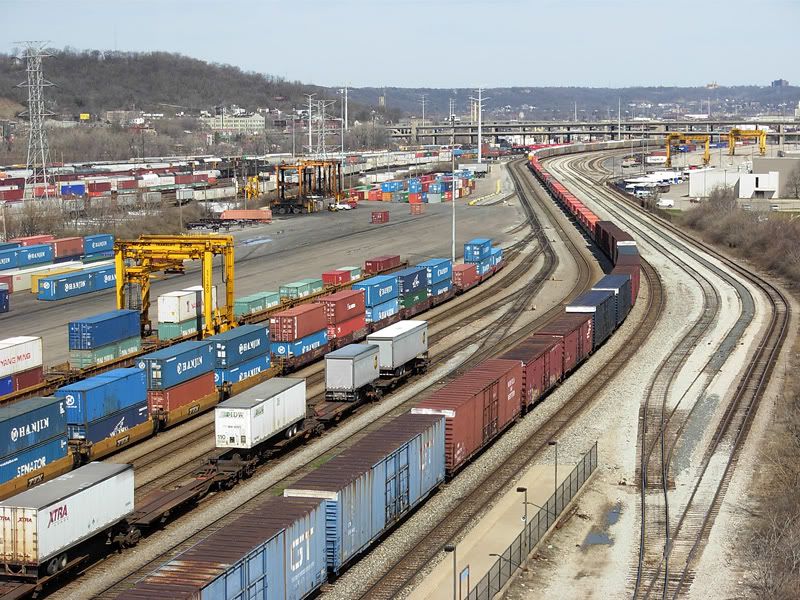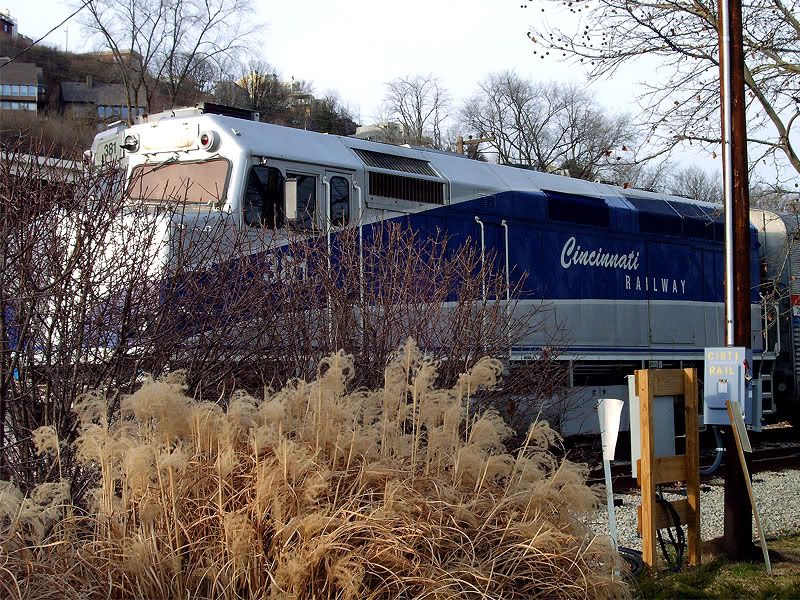 City manager Milton Dohoney Jr. says that Cincinnati City administration recognizes the concerns voiced by residents of Columbia Tusculum and the East End over a proposal to run intercity passenger rail through their neighborhoods, but that their judgment should be reserved until more solid plans are completed.
City manager Milton Dohoney Jr. says that Cincinnati City administration recognizes the concerns voiced by residents of Columbia Tusculum and the East End over a proposal to run intercity passenger rail through their neighborhoods, but that their judgment should be reserved until more solid plans are completed.
The 3C Corridor rail proposal would connect Cincinnati, Columbus, and Dayton via a rail network using existing freight rail lines.
One such line, an existing 17-mile stretch known as the Oasis Line, branches off from the Norfolk Southern line near Evendale and extends through the neighborhoods of Columbia Tusculum and the East End to the Cincinnati riverfront, ending near the Montgomery Inn Boathouse.
Because the line is lightly used and bypasses the congested Mill Creek valley, it has become attractive to both Amtrak and the Ohio Rail Development Coalition (ORDC), the arm of the Ohio Department of Transportation studying and advocating for both freight and passenger rail development in the state.
To establish a temporary passenger station in the City of Cincinnati, the ORDC advocates a location near the Boathouse because of its access to the tracks and location on a primary arterial, Riverside Drive.
Several residents of the affected neighborhoods sent communications to City council, voicing concerns about the negative effects of train traffic on residential development and property values, impacts to Theodore M. Berry International Friendship Park, blight, noise, a lack of parking, and a lack of connections to other modes of transportation.
But in a memo to City council, Dohoney stresses that no permanent route or station site has been chosen.
"ORDC feels that, while a station at the Boathouse may be favorable for the start-up service, it should not be the location for the permanent intercity passenger rail station for the City of Cincinnati," he says.
Diminishing development
Towne Properties' Arn Bortz objects to the placement of the station because it says that "the City has spent the past thirty years recapturing its riverfront from industry".
In addition to a string of parks, Bortz says that a substantial amount of private sector development has followed, with more investment promised. Towne Properties has built Captain's Watch and Foster's Point at Adams Landing along Riverside Drive, and plans more condominium development once the housing market picks up.
Towne Properties has built Captain's Watch and Foster's Point at Adams Landing along Riverside Drive, and plans more condominium development once the housing market picks up.
"The intrusion of a non-neighborhood friendly diesel train – it rarely stops – into the area threatens to destroy the potential for future development, negatively affect the quality of life for residents who've chosen to move into the area, and restrict access to the parks by the public at large."
Bortz also fears that the "temporary" terminal could end up not being so temporary after all.
"If there must be a 'temporary' solution to the east of our CBD, a terminal at Lunken Airport is a much more logical choice," he says. "It has adequate parking potential and does not sit in the middle of an intense area of new development."
Like many others, Bortz prefers the use of Union Terminal for a new station.
"While I understand that a fourth main may be a precondition for doing so, I urge you to become an advocate for such a strategy as it promises to do lots of good things for our City," he says. Left out of the loop
Left out of the loop
Laurie Keleher, president of the East End Area Council, says that her community has been largely left out of the conversation as a potential resource and partner.
She says that the council does see the overall value of train service to the City, but is worried about safety, pollution, and noise.
"How fast would the trains be traveling through our community?" Keleher says. "How much noise is expected from horn signaling? Diesel engines are notorious polluters, is that being taken into consideration? How big will the station be and what is the expected impact on the Park?"
Like Bortz, Keleher wonders what could be done to locate the passenger station at Union Terminal, and wonders if stimulus funding can be used to add an additional track to the congested Mill Creek valley.
In her opinion, not enough input has been sought in making routing decisions.
"We should all be working together to not only seek a 'temporary' solution, but to also plan for the long term success of passenger rail in Ohio," Keleher says.
In order to gather more information from City, state, and federal sources, the East End Area Council has formed the Eastern Riverfront Community Rail Study Committee.
While the investigative committee gathers information, Keleher asks that the City "avoid taking a position on where any aspects of the 3C project should be located".
Access to the river
Rick Griewe, a developer and self-proclaimed river lover who has helped secure capital funding for such projects as Sawyer Point, Yeatman's Cove, and the National Steamboat Monument, has his own idea for how rail should work in the City.
And it doesn't involve rail lines between residents, developable land, and one of the City's greatest natural resources.
"Heavy diesel powered trains will create a barrier between downtown and the riverfront for pedestrians and will lower the value of real estate along the Oasis Corridor which is one of the most valuable development sites in the region," Griewe says.
Griewe notes that $156 million of residential and commercial projects have been completed between Broadway and Delta Avenue, with another $635 million in projects proposed.
Additionally, $36 million has been invested in riverfront parks with another $60 million on the table. Electrified light rail or streetcars are the answer, Griewe says.
Electrified light rail or streetcars are the answer, Griewe says.
"The track lays flush in the streets, it's quiet, no smell and this type of rail can stop and start quickly," he says. "This technology has fueled transit-oriented development throughout the nation and could jumpstart the proposed residential projects along the Oasis Corridor."
His idea includes a temporary station that could link to the light rail/streetcar line at Wilmer Avenue, one block from Lunken Airport.
"The 79-mph Amtrak trains could start here and, if the Ohio Rail Development Coalition has the funds to provide connecting service to downtown from Wilmer, build light rail into the Transit Center under Second Street or streetcars that hook into the proposed Downtown/Uptown system," Griewe says. "This investment would not be wasted, Hamilton County's Eastern Corridor Project could expand the light rail service to the eastern suburbs." Griewe also believes that the best location for a 3C and Midwest Regional Rail Initiative passenger station is Union Terminal, and the Mill Creek valley could accommodate a fourth track.
Griewe also believes that the best location for a 3C and Midwest Regional Rail Initiative passenger station is Union Terminal, and the Mill Creek valley could accommodate a fourth track.
"Everyone in Cincinnati should support the State's effort to build modern passenger rail," he says. "It will connect our beautiful river city with the Midwest!"
Advocates exist
David Lyman, a writer and interested Columbia Tusculum resident, supports the preliminary 3C Corridor proposal because he wants to see the entire Lunken-Downtown corridor improved for all sorts of rail traffic.
"I see that improvement as a necessary precursor to light rail along the same route," he says, adding that the addition of rail would lower automobile traffic along Columbia Parkway, Kellogg Avenue, and Riverside Drive. "In time I would like to see easier, greener commuting between the east side and downtown, both for environmental reasons and in terms of making my neighborhood - Columbia Tusculum - more robust."
To Lyman, rail represents potential. "There was a time not so long ago that Eastern Avenue in Columbia Tusculum was a bustling residential and commercial center much like Ludlow Avenue in Clifton is today," Lyman says. "I think light rail is key to that happening."
"There was a time not so long ago that Eastern Avenue in Columbia Tusculum was a bustling residential and commercial center much like Ludlow Avenue in Clifton is today," Lyman says. "I think light rail is key to that happening."
He also doesn't buy the arguments about increased noise and decreased safety, and says that the benefits of increased property values and a diminished reliance on cars outweigh any fears.
"Barges on the river already create more noise than we're likely to have from train traffic," Lyman says. "And besides, we're not talking about dozens of trains a day. If a high-speed train is routed through Columbia Tusculum, it certainly won't be traveling at those high speeds in such a densely populated area."
A fundamental misunderstanding of rail travel has led to many of these fears, Lyman says.
"When we want to go somewhere, we don't turn to trains as a solution," he says. "They simply haven't been a reasonable option in this area for more than 50 years."
Our love of the freedom that automobiles give us and the project's price tag also contribute to public skittishness, he says.
"Too often these days, we look only at the short term ramifications of an idea," Lyman says. "As citizens, we've begun to think like politicians - only as far as the next election or then next tax bill in our mailboxes. If citizens who came before us had thought that way, we wouldn't have the magnificent network of parks that we do in Greater Cincinnati. We wouldn't have the system of Interstate highways. Those things aren't direct generators of profit."
What those things do, Lyman says, is make our communities better places.
"They make our lives easier," he says. "In my opinion, these are the sorts of projects that should be the highest priorities of tax dollars. Tax dollars need to lead the way, to do those things that profit-making, bottom-line-oriented businesses can't justify."
In Lyman's opinion, any attempt to restore train service to Union Terminal should be off the table – not only are The Banks, Dixie Terminal, or the Public Landing better locations, but they're in the center City too.
"I don't see Union Terminal as the best site as the terminus of this line at all," he says. "The building has a new use now. Trains may be its history, but they are secondary. Or an even lower priority. If you've ever arrived on the train from Chicago at 3 a.m. or so, it is obvious that train travelers are a complete afterthought."
Then, there are purely aesthetic reasons.
"The trainyards and backsides of factories are not what I want people to see as they're arriving in Cincinnati," Lyman says. "I'd rather they come down the valley leading to Lunken Airport."
Dohoney addresses concerns
Dohoney says that the City is hearing and considering residents' concerns.
"The City understands that residents living along Riverside Drive have concerns about the proposed new service, including the speed of the trains, the size of the trains, noise, air quality, and the size of the station," he says. "Similarly, the Cincinnati Recreation Commission and the Parks Department have also expressed concerns regarding parking impacts on International Friendship Park and Bicentennial Commons."
Right now, Amtrak is working on an operational plan that will provide further details on the proposed service. Additionally, both Amtrak and ORDC are pursuing diesel multiple unit equipment (DMU), which doesn't require a locomotive, for the start-up service.
Additionally, both Amtrak and ORDC are pursuing diesel multiple unit equipment (DMU), which doesn't require a locomotive, for the start-up service.
Dohoney says that this is not the same technology powering the Cincinnati Railway Company dinner train that currently utilizes the tracks.
"If the decision is made to use a diesel locomotive to pull passenger cars instead of the DMUs, the locomotives will be new state-of-the art locomotives," he says. "The locomotive used to pull the Dinner Train is in the second generation locomotive class which was constructed in the 1960s. Today's locomotives have much higher emission standards."
Dohoney also says that he has heard concerns about a drop in property values that 3C trains could cause in the neighborhoods through which they pass.
"From examples in other parts of the country, we do not see this trend," he says. "In cities such as Portland, Oregon, new condos have been built near the Amtrak station which has significant rail service. Residents see the service as a convenience."
Finally, Dohoney says that the use of Union Terminal as a passenger station is likely out of the question because its only current train service, Amtrak's Cardinal line, stops on the CSX mainline only long enough to load and unload passengers.
With no passenger storage tracks, Union Terminal would need to negotiate property acquisition with both CSX and Norfolk Southern.
But Dohoney's ultimate argument is that the Oasis Line is already an active railroad.
"The railroad operator, the Indiana and Ohio Railroad, has the ability to use the line in any way which makes good business sense for the company, which includes hosting passenger operations," he says. "The proposed Amtrak service is four trains per day – two in each direction."
City council passed a resolution supporting the 3C Corridor plan, in principle, in February. Ohio launches site
Ohio launches site
The Ohio Department of Transportation and ORDC have started a new website for the 3C Corridor project called 3C is ME.
The site features links and resources for the plan, as well as a comment box that allows users to send feedback directly to the ORDC.
Users also can find details about other high-speed passenger rail initiatives proposed throughout the United States.
Later this fall, the U.S. Department of Transportation and Federal Railroad Administration will determine which states receive a share of the $8 billion in American Recovery and Reinvestment Act funds made available for passenger rail.
The State of Ohio filed its pre-application for these funds on July 10.
The 3C Corridor plan is seen as the first step to development of the Ohio Hub system, a $3 billion-$4 billion transit project composed of high-speed trains running along 1,244 miles of track and serving 46 stations.
"Northbound Amtrak" by reivax, courtesy of Flickr. DMU photo courtesy of Chris McKenna through the Creative Commons Attribution ShareAlike license. Streetcar photo courtesy of http://http//www.cincystreetcar.com/index.html
Previous reading on BC:
Cincinnati EDC to consider resolution of support for Ohio passenger rail service (2/23/09)
All Aboard Ohio: Stimulus bill may ignore Ohio's train and transit needs (1/21/09)
Thursday, August 6, 2009
Caution, communication needed in 3C Corridor choices
Posted by
Kevin LeMaster
at
5:10 AM
![]()









